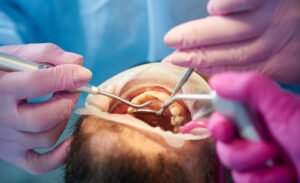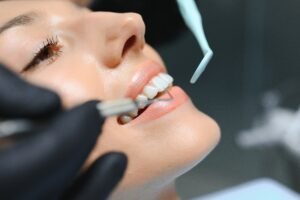One of the best ways to restore your smile after losing one or more teeth is with a dental bridge. There are many different reasons why patients need to replace their teeth. The most effective technique to stop teeth from falling out is to visit the best dentist in Calgary NE frequently. Your daily priorities should start with maintaining good dental hygiene. Even good dental hygiene isn’t enough for certain people. Anybody could require a replacement tooth. You can use drugs that are bad for your bones, or you might have been in a mishap and lost a one or two tooth. And that’s why it becomes necessary for you to get dental bridges in Calgary to stop the pain.
For as long as possible, everyone wishes to maintain their natural teeth. In certain situations, patients search for alternatives when this is not an option. Dental operations allow us to achieve our goals of having a positive first impression and confidence in daily life.
Defining dental bridge
As its name implies, a dental bridge fills in any gaps left by missing teeth in your mouth by acting as a form of a bridge. A prosthetic tooth and dental crowns are two of the components that make up the dental bridge.
Read More: The Benefits of Orthodontic Treatment in Calgary: Beyond Straight Teeth
Types of dental bridges
The dentist may suggest any of the following dental bridge types depending on the position and quantity of lost teeth.
Traditional dental bridge
Dental bridges consist of an artificial tooth that fills the empty socket, and dental crowns hold it in place by attaching to the neighboring teeth on each side of the gap. For this procedure, the dentist needs the patient’s healthy teeth on either side of the gap. The dentist will contour or trim these teeth to ensure the dental crowns fit comfortably.
Must See: A Parent’s Guide to Children’s Dental Care: Establishing Healthy Habits Early
Cantilever bridges
These bridges resemble conventional bridges in many ways. The dentist inserts a prosthetic tooth into the vacant socket and secures it with a dental crown attached to healthy teeth on one side of the gap.
Implant-supported bridges
These bridges use tiny titanium posts that the surgeon inserts into the jawbone. Unlike other bridges, they don’t rely on nearby teeth for support. The procedure is more complicated due to the surgery involved, and you may need a longer recovery time. However, these bridges are sturdier than traditional options and can last much longer.
Check Now: What Is a Dental Bridge and How Does It Improve Oral Health?
Maryland bridges
Metal frames hold the prosthetic teeth in place for these bridges. Dentists recommend these bridges when the patient’s teeth on either side of the gap are unhealthy.
Why do you need dental bridges?
To use a dental bridge, you mostly need to have one or more teeth in your mouth that are missing. By replacing the lost tooth with one that can mimic the appearance of the original, dental bridges help you regain the appearance of your smile. The dental operation can restore or preserve normal chewing, biting, and speaking as well as the proper form for your bite and the proper shape of your face, in addition to the cosmetic benefits of dental bridges Calgary NE.
Read More: Understanding Different Types Of Root Canal Treatments
By inserting an artificial tooth in the gap created by a lost tooth, you may prevent the neighboring teeth from shifting or migrating into the space left by the tooth, which might throw your entire bite out of alignment.
Step-by-step dental bridge treatment
First appointment
If you’re considering dental bridges, schedule a dental exam with your dentist. They will evaluate your situation to determine the best Dental treatment plan in Calgary. If your dentist gives the green light, they will book you for the main procedure.
Prep for the bridge
To start, the dentist numbs the region around the lost tooth to relieve any pain and maintain your composure. Afterward, the dentist cleans the region to eliminate plaque and bacteria.
Read More: What are the Different Types of Professional Teeth Whitening Treatments?
The dentist prepares the surrounding teeth so the crown can fit correctly (for traditional and cantilever bridges). To produce the final prosthesis, the dentist sends a scan and imprints of the patient’s teeth to the lab.
The dental practitioner will choose crowns that are the same shade as your natural teeth. The teeth are shielded from harm by a temporary bridge glued to them. When the permanent bridge is prepared, you will be sent home and contacted at the dentist’s office for the bridge.
Final fixing
Your dentist in Calgary will remove the temporary bridge and fit the permanent one once it’s ready. If the bridge fits properly, the dentist will secure it using stronger cement. They will then scrape off any excess cement and polish the bridge to ensure it looks as natural as possible. You’ll be all set to return home afterward.
Do dental bridges cause pain?
Your family dentist in Calgary will take every precaution to minimize discomfort during the procedure. They will administer a local anesthetic to numb the area. You can feel confident knowing that your dentist is skilled and genuinely cares about your comfort.
Read More: Common Orthodontic Problems, and How to Treat Them?
Receiving a bridge often involves at least two visits and takes one to two hours. Patients who know they will receive a bridge should consider whitening their teeth. When you get your bridge, it will be a stunning white, and you want it to blend in as naturally as possible.
How to care for dental bridges?
You must take care of your dental bridges without worrying. Many patients are shocked to learn that caring for and maintaining dental bridges is the same as caring for natural teeth. Following the dental bridge installation, you should brush daily and floss at least once. This will aid in preventing tooth decay surrounding your other teeth and the dental bridge. Gum disease may be avoided by regularly brushing and flossing.
Must See: Things to Do When You Have an Emergency Dental Situation
In addition to day-to-day brushing and flossing, you should also plan frequent trips to the dentist. In addition to inspecting your teeth for any potential issues during your visit, your dentist can also thoroughly clean them. Tartar and plaque that are difficult to remove with simple brushing and flossing may frequently be eliminated by a professional cleaning.















